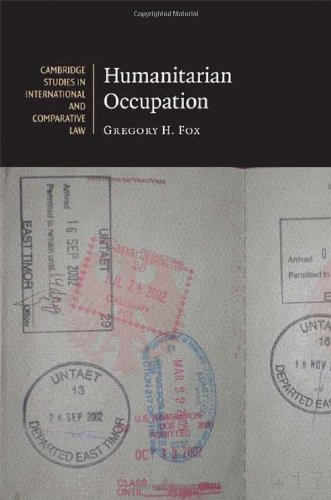Gregory H . Fox0521856000, 9780521856003, 9780511388682, 9780521671897, 0521671892, 9780511386671
Table of contents :
Cover……Page 1
Half-title……Page 3
Series Title……Page 4
Title……Page 5
Copyright……Page 6
Dedication……Page 7
Contents……Page 9
Acknowledgments……Page 13
Introduction……Page 15
I. Why humanitarian occupation?……Page 18
II. Legal Justifications……Page 22
IV. A Collective innovation……Page 26
Section I Historical antecedents……Page 29
1 The historical origins of humanitarian occupation I: governance in service of outsiders……Page 31
I. Origins in the nineteenth century……Page 33
II. Territories administered as a result of the 1919 settlement……Page 34
A. Fashioning international authority……Page 37
B. The mandatories’ governance obligations……Page 40
C. The locus of sovereignty debate……Page 42
IV. United Nations trusteeship territories……Page 47
V. Conclusions……Page 53
2 Historical origins of humanitarian occupation II: internationalized territory in service of insiders……Page 55
I. The rise of post-conflict reconstruction……Page 59
II. Common tasks and objectives……Page 62
A. Territorial integrity……Page 65
B. Democratic politics……Page 66
C. Human rights……Page 69
III. Centrality of consent……Page 72
A. The role of consent in post-conflict missions……Page 73
B. Actual consent……Page 78
C. Constructed consent……Page 82
IV. Conclusions……Page 83
3 Full international governance……Page 86
A. Following the territorial imperative……Page 88
B. Creating consent……Page 90
C. The Dayton model of statehood……Page 92
A. The genesis of the conflict and early international involvement……Page 98
B. Escalating international involvement……Page 101
C. The Rambouillet conference……Page 103
D. War and peace……Page 105
E. The Interim international administration……Page 107
F. Final status negotiations……Page 109
G. Observations……Page 111
A. From voting to violence……Page 112
B. Pressure to internationalize……Page 114
C. The UNTAET mandate……Page 116
D. United Nations statehood?……Page 117
IV. The Eastern Slavonia mission……Page 120
V. Conclusions……Page 124
Section II Why humanitarian occupation?……Page 127
4 Rejected models of statehood……Page 129
I. Introducing the policy options……Page 132
II. Legal constraints on exclusionary nationalism……Page 135
A. No legal support for homogeneity achieved through murder, subordination or forcible conversion……Page 137
1. The argument for separation……Page 139
2. The rejection in practice……Page 140
3. Procedural limitations and transaction costs……Page 146
4. Negotiated partition……Page 148
C. No legal support for mass population movements……Page 150
III. Conclusion: what remains? the politics of inclusion……Page 154
5 Constructing the liberal state……Page 156
I. The stubborn persistence of a state-centered order……Page 157
A. The empirical claim……Page 158
B. The normative claim……Page 162
A. The mainstreaming of democracy promotion……Page 168
B. Procedural versus substantive democracy……Page 171
III. Elections……Page 176
IV. Human rights……Page 181
V. Conclusions……Page 186
Section III Legal justifications……Page 189
A. The coercion problem……Page 191
B. The prohibition on coerced treaties……Page 193
C. The humanitarian occupation agreements……Page 195
1. The Nature of the coercion……Page 202
2. The nature of the agreement……Page 206
3. Justifiable force?……Page 209
II. Second legal framework: Security Council fiat……Page 214
A. Limits on Council authority within the Charter……Page 215
1. The self-determination claim……Page 219
2. Difficulties with jus cogens limitations……Page 225
3. An alternative methodology: implied consent……Page 228
III. Conclusion……Page 231
7 The international law of occupation……Page 232
I. Applicability of occupation law to multilateral humanitarian occupations……Page 236
A. UN ratification of humanitarian law treaties……Page 237
B. The UN and the customary law of occupation……Page 239
C. The nature of UN customary law obligations……Page 244
A. The prohibition against altering legal and political institutions in the occupied territory: the conservationist principle……Page 247
1. Military necessity……Page 251
2. Obligations imposed by the Fourth Geneva Convention……Page 252
1. A reformist reading of occupation law……Page 256
2. Is the conservationist principle an anachronism?……Page 263
A. The occupation of Germany……Page 269
1. Social engineering in Iraq……Page 273
2. Did the Security Council endorse a “transformative occupation”?……Page 277
3. Resolution 1483 as precedent……Page 283
IV. Conclusions……Page 284
8 Reforming the law: the Security Council as legislator……Page 287
I. Transcending state-centric norms……Page 288
A. Normative origins……Page 289
B. The reciprocal nature of state-centric norms……Page 293
C. State-centric norms and a collective agenda……Page 299
D. Lack of adjudicatory mechanisms……Page 300
II. Security Council legislation……Page 302
A. A distinct competence……Page 303
B. Council legislation in practice……Page 304
C. Legitimating legislative acts……Page 308
1. Subjective element: norms and state interests……Page 309
2. Objective element: supportive practice……Page 313
III. Conclusions……Page 317
Conclusions……Page 319
Index……Page 323
Cambridge studies in international and comparative law……Page 335

Reviews
There are no reviews yet.